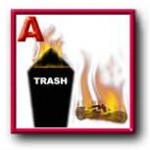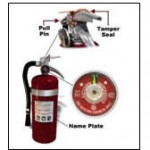Fire Extinguisher Safety
 Tuesday, March 2, 2010 at 03:44PM
Tuesday, March 2, 2010 at 03:44PM  Being prepared and able to fight small fires can prevent massive fire damage and save you the need for fire and smoke restoration services.
Being prepared and able to fight small fires can prevent massive fire damage and save you the need for fire and smoke restoration services.
Before considering fighting any fire there are a few things that you should know.
Choosing the Right Fire Extinguisher Fire Extinguishers must be (UL) Underwriters Laboratory approved. UL is a testing laboratory that is nationally recognized. They verify compliance with OSHA standards 29.CFR 1910.157(c)(2). Once a Fire Extinguisher has passed all the tests they are given an alpha numeric classification based on the type and size of the fire it will extinguish.
Fire Extinguishers must be (UL) Underwriters Laboratory approved. UL is a testing laboratory that is nationally recognized. They verify compliance with OSHA standards 29.CFR 1910.157(c)(2). Once a Fire Extinguisher has passed all the tests they are given an alpha numeric classification based on the type and size of the fire it will extinguish.
Letter & Types of Fire
A: Wood, paper, cloth, trash, rubber, plastic, & other ordinary materials
B: Gasoline, grease, oil, paint and other flammable liquids
C: Live electrical equipment, wiring fuse boxes, or computer
D: Combustible Metals of magnesium, titanium, potassium, and sodium.
K: Kitchen - Oils and Fats



Choose the proper location(s) of your fire extinguisher
It is important that the correct type and size of an extinguisher is located near potential hazards.
Do not place a fire extinguisher in your hazard zone.
Example: A fire extinguisher placed right above a stove, would not be accessible if the stove were to catch on fire.
When not to Fight a Fire - Fight or Flee
Do not fight a fire if……
- The fire is spreading beyond the spot where it started.
- The fire is blocking your escape route.
- You don’t have an adequate fire extinguisher.
- The Fire is partially hidden behind a wall or ceiling, or can not be reached from a standing position
- Due to smoke and products of combustion, the fire can not be fought without respiratory protection.
- The radiated heat is easily felt on exposed skin making it difficult to approach within 10-15 feet of the fire (or the effective range of the extinguisher).
- One must crawl on the floor due to heat or smoke.
- Smoke is quickly filling the room, decreasing visibility.
How to Fight a Fire (P.A.S.S.)
1. The first thing you must do is call 911.
2. Inspect your extinguisher
a. Make sure it’s the right classification
b. Make sure it is full
Follow the acronym P.A.S.S. P: Pull the Pin
P: Pull the Pin
A: Aim - the extinguisher nozzle at the base of the flames.
S: Squeeze – the trigger while holding the extinguisher upright
S: Sweep – the extinguisher from side to side covering the area of the fire with the extinguishing agent.
When to leave the area immediately
Make sure you leave the area immediately when...
- Your path of escape is threatened.
- Your extinguisher runs out of agent.
- Your extinguisher is ineffective
- When you no longer are able to safely fight the fire.
Cherrise Kelley - Human Resources / Administration / Receptionist
 Buildings and Real Estate,
Buildings and Real Estate,  Champion,
Champion,  Champion Construction Systems,
Champion Construction Systems,  Commercial Property,
Commercial Property,  Community News,
Community News,  Community Service,
Community Service,  Education,
Education,  Emergency Planning,
Emergency Planning,  Fire Damage,
Fire Damage,  Fire Extinguisher Safety,
Fire Extinguisher Safety,  Georgia,
Georgia,  Insurance,
Insurance,  Restoration,
Restoration,  Training,
Training,  champion construction,
champion construction,  cherrise kelley,
cherrise kelley,  choosing the right fire extinguisher,
choosing the right fire extinguisher,  disaster,
disaster,  disaster planning,
disaster planning,  disaster preparedness,
disaster preparedness,  equipment,
equipment,  fire,
fire,  fire and smoke restoration services,
fire and smoke restoration services,  fire damage atlanta ga,
fire damage atlanta ga,  fire extinguisher,
fire extinguisher,  fire extinguisher classification,
fire extinguisher classification,  fire extinguisher location,
fire extinguisher location,  fire safety,
fire safety,  how to fight a fire,
how to fight a fire,  safety,
safety,  sharpsburg
sharpsburg  Email Article
Email Article 

Reader Comments